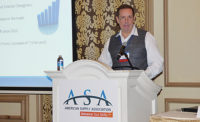Industry associations develop programs to attract workers
Topics discussed were workforce development, water efficiency and waterborne diseases.


|
|
ASA Executive Vice President Mike Adelizzi discusses workplace development during the Plumbing Industry Leadership Coalition meeting in Washington. Dan Hilton, ASA’s government affairs director, listens at right. Photo by Bob Miodonski/ Supply House Times |
Workforce development, water efficiency and waterborne diseases were among the issues discussed April 22 during the third annual meeting of the Plumbing Industry Leadership Coalition in Washington.
PILC brings together executives of industry groups such as the Plumbing-Heating-Cooling Contractors – National Association, Mechanical Contractors Association of America, American Supply Association, Plumbing Manufacturers International, American Society of Plumbing Engineers, United Association, International Code Council and International Association of Plumbing and Mechanical Officials.
The shortage of employees caused by workers who have retired or left the industry during the recession – as well as competition from other industries – has raised concerns at all levels of the plumbing industry. Cindy Sheridan of PHCC and Mike Adelizzi of ASA presented a report on what associations are doing to attract more people to work in the plumbing industry.
“At the current rate of retirement, it is estimated that by 2016 the industry will need 700,000 new workers,” Adelizzi said. “Part of the challenge of filling these jobs is changing the image of the industry and letting students, counselors, parents and military veterans know about the lucrative career opportunities that are available.”
ASA has partnered with Industrial Career Pathways, a consortium of associations dedicated to educating high school, college and technical school students about careers in industrial distribution. ASA also has launched its own Women in Industry group and developed a career site.
Following the PILC meeting, the group circulated a letter urging U.S. Senate members to support the WaterSense Efficiency, Conservation and Adaptation Act of 2014. The legislation seeks to improve water-use efficiency and promote smart water systems to conserve water and reduce costs.
HELPFUL LINKS:
Looking for a reprint of this article?
From high-res PDFs to custom plaques, order your copy today!








